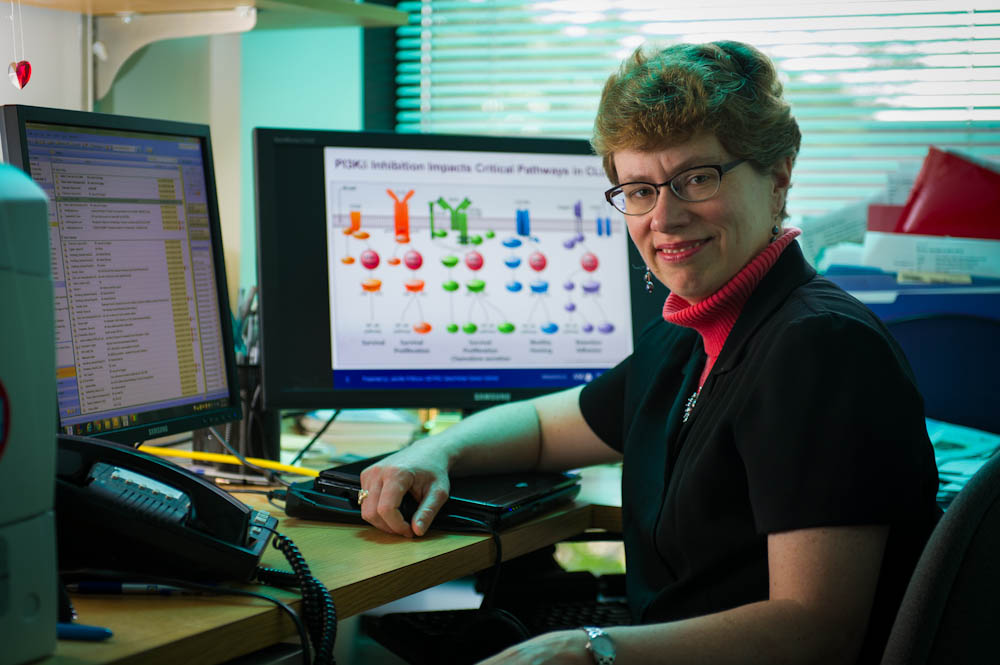Dana-Farber scientists have found that a generic anti-microbial drug can block a key molecular driver of chronic lymphocytic leukemia (CLL) cells, and when tested in a small clinical trial of advanced CLL patients who had relapsed, the drug slowed disease progression in half of them.
The drug, pyrimethamine, achieved stable disease in eight of the 16 patients in the trial, with one patient remaining on the drug for a year and two others for four and six months before the leukemia progressed. The patients had all received multiple treatments that were no longer working.
“This is particularly unusual and encouraging for a single-agent, non-toxic drug,” says David Frank, MD, PhD, senior author of a report on the trial in the American Journal of Hematology. First author is Jennifer R. Brown, MD, PhD, director of the CLL Center of the Division of Hematologic Malignancies at Dana-Farber.
He says the drug, which has been used to treat parasitic infections in patients with AIDS and as a preventive for malaria, is well tolerated, and that patients could probably receive higher doses than those used in this small clinical trial, and for longer periods of time, perhaps achieving greater responses. Frank says that the drug caused leukemia cells to self-destruct through apoptosis, and that pyrimethamine also appears to make cancer cells more visible to the immune system, suggesting that it could be combined with immunotherapy drugs in future trials.
“They might have a synergistic effect,” he says.
Finding the target

Frank and his colleagues homed in on pyrimethamine several years ago while searching for drugs that could target the transcription factor known as STAT3. Transcription factors are proteins that turn genes on and off to direct key processes such as cell division, growth, and survival. Inappropriately activated STAT3 has been implicated in many cancers, and particularly in CLL.
Frank says that abnormal STAT3 is found in nearly all patients with CLL, which is the most common type of leukemia, and for which there presently is no cure. Brown notes that despite great advances in CLL therapy in recent years, there is still a need for new drugs, particularly drugs with a strong biologic rationale for their activity in CLL, like pyrimethamine.
Frank has had long experience with pyrimethamine.
“When the AIDS epidemic emerged, many patients had toxoplasmosis, a parasitic disease, and we treated it with pyrimethamine at concentrations that patients can have for months at a time,” she says.
More recently, when pyrimethamine showed up in a screen for drugs that blocked STAT3, she says “we felt, let’s give this a try in patients with CLL who have advanced disease after being treated with many therapies.”
Laboratory studies showed that pyrimethamine blocked STAT3 in CLL cells, and when administered to patients in the clinical trial, the drug blocked STAT3 and stabilized the leukemia in half of the patients, though they ultimately progressed. Frank says that the drug would likely be more effective at doses higher than those given in the study, “which should be feasible and safe based on our data.”
Brown is interested in the potential for combining pyrimethamine with other signaling inhibitors used to treat CLL, such as BTK or PI3K inhibitors, or a BCL2 inhibitor active in CLL, such as venetoclax. She notes that combination therapy is needed to reduce the likelihood of the development of resistance, which currently is what leads to failure of these drugs.
Frank emphasizes that the trial and its results “are a real Dana-Farber study,” involving laboratory-to-bedside research, and that the majority of funding was obtained through a peer-reviewed grant from the Lymphoma Research Foundation.
“This is a great example of how disease-focused foundations, which are looking to fill a niche in the development of new therapies, can have a powerful impact in developing new treatments for our patients,” Brown notes.

Does this treatment show promise for other types of blood cancer, particularly NHL? Could it be used for cancer in other parts of the body, such as cancer in the brain?
Hi Mary,
We received an answer from one of our clinicians on your question:
“The short answer is “yes.” Brain cancers are known to frequently have activated STAT3 and pyrimethamine is also known to penetrate into the brain very well. There is an active interest in using pyrimethamine, likely in conjunction with other therapies, for the treatment of adult and pediatric brain cancers.
Similarly, NHL and many other forms of leukemia are driven by the over-activation of STAT3. We are looking to develop clinical trials of pyrimethamine (and other STAT3 inhibitors we have identified at DFCI) for studies in these diseases. We are particularly interested in how these STAT3 inhibitors may be particularly active when combined with immune-based therapies.”
We hope this is informative and are wishing you all the best,
DFCI